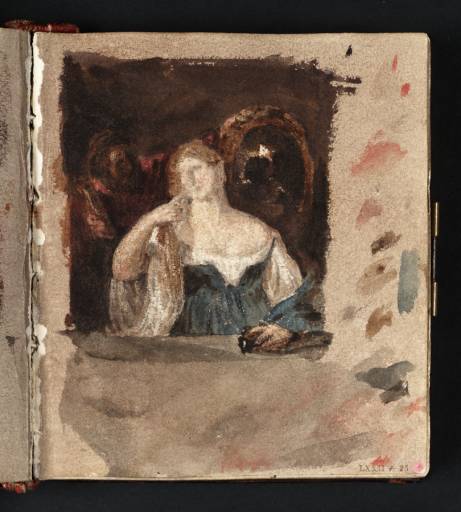Joseph Mallord William Turner Woman with a Mirror, after Titian 1802
Joseph Mallord William Turner,
Woman with a Mirror, after Titian
1802
Joseph Mallord William Turner 1775–1851
Folio 25 Recto:
Woman with a Mirror, after Titian 1802
D04301
Turner Bequest LXXII 25
Turner Bequest LXXII 25
Watercolour over pencil on white wove paper prepared with a pale reddish brown wash, 128 x 114 mm
Inscribed by John Ruskin in red ink ‘25’ bottom right
Stamped in black ‘LXXII–25’ bottom right
Inscribed by John Ruskin in red ink ‘25’ bottom right
Stamped in black ‘LXXII–25’ bottom right
Accepted by the nation as part of the Turner Bequest 1856
References
1909
A.J. Finberg, A Complete Inventory of the Drawings of the Turner Bequest, London 1909, vol.I, p.183, LXXII 25, as ‘Copy of Titian’s so-called “Mistress”, now known as “Alphonse de Ferrare et Laura de’ Dianti”’.
1961
Alexander J. Finberg, The Life of J.M.W. Turner, R.A. Second Edition, Revised, with a Supplement, by Hilda F. Finberg, revised ed., Oxford 1961, pp.85–6.
1981
Michael Kitson, ‘Turner et Claude’, in Maurice Guillaud and others, Turner en France, exhibition catalogue, Centre Culturel du Marais, Paris 1981, pp.85, 86 reproduced in colour fig.51.
1993
Jean-Pierre Cuzin and Marie-Anne Dupuy, Copier créer. De Turner à Picasso: 300 oeuvres inspirées par les maîtres du Louvre, exhibition catalogue, Musée du Louvre, Paris 1993, pp.80–1, reproduced fig.276.
2003
Ian Warrell, David Laven and others, Turner and Venice, exhibition catalogue, Tate Britain, London 2003, p.54 reproduced fig.35.
This famous and tantalising picture, an early work by Titian (Tiziano Vecelli circa 1477–1576), was in the Gonzaga collection in Mantua and that of Charles I, and possibly also that of the painter Anthony Van Dyck, in London. It was bought by Louis XIV in 1662. Among the Louvre’s collections it was almost as legendary as the Concert-champêtre, then also believed to be by Titian – see folios 56 verso–57 of this sketchbook (D04347–D04348) for Turner’s copy – and with which it shares common themes. Possibly depicting a courtesan with her lover, its strongest appeal to the Romantic mind was as a portrait. In Turner’s day it was thought to depict Titian himself with his mistress and it has since been associated with Alfonso d’Este of Ferrara and Laura de’Dianti, or more recently with Federico Gonzaga and Isabella Boschetti. However, such identifications add little to a work likely to be an allegory of love and the transience of beauty.
It is no surprise that Turner sought this picture out. See the introduction to this sketchbook for Joseph Farington’s diary note that he found the picture suddenly placed in the Louvre’s Grande Galerie on 18 September 1802. Two days earlier Farington and Benjamin West had been able to study it ‘in a back place partitioned off’, under the supervision of an attendant. Farington thought it ‘exceeds in beauty, simplicity, breadth and every other requisite any portrait that I have ever seen ... When examined near it seems the perfection of painting, there is melting softness and beauty in rendering the tints that is exquisite’.1 For Turner’s own comments see chiefly folio 24 of this sketchbook (D04300). His copy fills two thirds of the page, the right and lower areas being used for testing his watercolour palette. Turner made a special point of copying the Louvre’s Titians in colour – see especially his copies of the Entombment and Christ Crowned with Thorns, folios 32 and 52 (D04315, D04340) – as well as the Concert-champêtre. Together with his extensive colour notes, evidence of his special interest in Titian comes from Farington, who joined him in viewing the painter’s Supper at Emmaus in ‘a back room’ on 7 October.2 There was apparently no opportunity to copy or comment on that work. Farington had, however, perhaps seen Turner working on his copy of the Concert-champêtre two days earlier.3
David Blayney Brown
July 2005
How to cite
David Blayney Brown, ‘Woman with a Mirror, after Titian 1802 by Joseph Mallord William Turner’, catalogue entry, July 2005, in David Blayney Brown (ed.), J.M.W. Turner: Sketchbooks, Drawings and Watercolours, Tate Research Publication, December 2012, https://www

